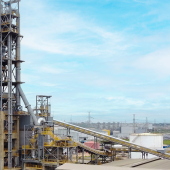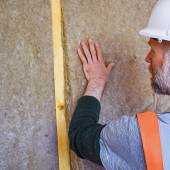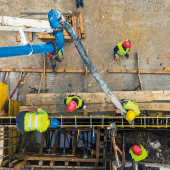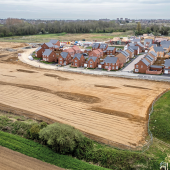How construction can get to net zero by 2050
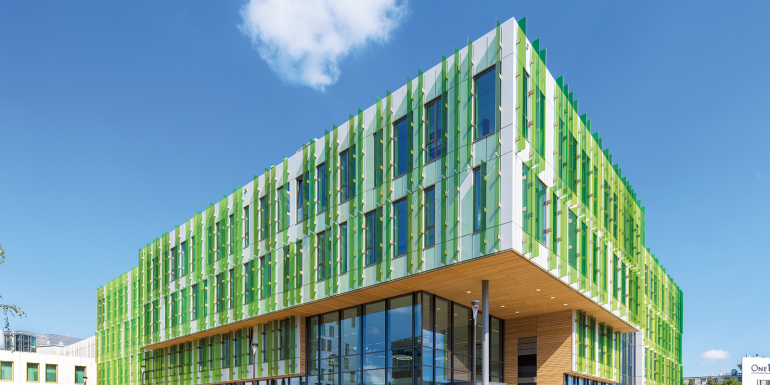
The Park 20|20 SHARE Hoofddorp office development, which was created using materials designed to be reused at the end of its lifespan
How could the specification of materials in construction projects help the industry reach net zero carbon targets by 2050? Futurebuild asks four experts
The challenge lies in changing the culture around construction
Dr Gavin Dunn, CABE CEO and former Chair of the Future Homes Standard Working Group for the Building Regulation Advisory Committee (BRAC), has worked to bring in new updates to building regulations (Part F: ventilation; Part L: energy conservation; Part O: covering methods to prevent overheating; and Part S: covering the provision of electric car charging – collectively known as FLOS) that have been in effect since June 2022 and will make new-build homes both climate-friendly and climate-resilient. The regulations, however, are just a baseline. He says: “Regulations can help dictate which materials must be specified when constructing a building – and those choices affect the whole supply chain. But choosing materials happens at specification, where the opportunity to go above and beyond in terms of sustainable construction lies, while legal standards only set the bare minimum.” The opportunity, but also the challenge, he notes, lies in changing the culture of construction. “The culture of our sector at the moment is all too driven by the lowest capital costs, minimum requirements, designing for compliance – all the things that aren’t going to get us where we need to be.”
Dunn wants the regulatory standards to be an ever-improving baseline and believes the UK excels at producing some of the best voluntary standards in sustainable construction and performance such as BREEAM and LEED. For the unconvinced, Dunn says that going above the minimum requirements pays back, even if the initial capital costs are higher, and the payback isn’t just in energy bills or the lifetime of the materials, it is in the wider social and environmental benefits. While the minimum requirements in the regulations may not go far enough by themselves, the Future Homes Standard will be the biggest change to building regulations in 30 years. From 2025, energy conservation standards (Part L in England) will require buildings to perform more than 30% above the previous standard in terms of carbon efficiency. For energy use, natural gas is out and heat pumps are in. This is a break with tradition – for the past 30 years builders have been encouraged to use natural gas to heat homes, as it was considered relatively cheap and clean. However, gas flue emissions still add to greenhouse gas emissions, and at the street level in large cities like London, the prevalence of gas boilers is adding to air quality issues affecting human health.
Sustainability remit wider than reducing carbon emissions
Indoor air quality is also a huge factor in respiratory health, which is why smart ventilation is required (Part F). “Our buildings are under-insulated,” Dunn sums up simply. “Getting fresh air into a building is important and can be a challenge as insulation performance increases, so the two measures must work in tandem. As we tighten the energy requirements, we need to ensure homes are properly ventilated.” The 2022 European heatwave is a testament to this. “The numbers are scary… as many as half the homes in this country will be suffering overheating by 2050,” he notes. According to UCL data, overheating could cause 4,500 excess deaths per year – many more than annual fatalities in fires or structural failure.
If the government takes up recommendations from its Parliamentary Select Committee, whole house and material life-cycles could be required for new homes from 2025. That would mean calculating the carbon emissions from building materials used over the expected life of the dwelling and what happens upon their disposal, renovation or reuse. The remit of improving sustainability is wider than improving operational energy performance; it is even wider than net zero’s focus on carbon emissions. There is a bigger social and environmental picture, says Dunn: “We’re finding ourselves looking at the wider impacts: social capital, social equality, inclusivity, ecology – all these things are linked, and the potential to add so much more value is huge. I genuinely believe as a sector we can do so much better for the people that buy buildings, and also for the climate, and we could build a more profitable, more valuable and nicer industry while we do it. It requires everyone to come together, and if we just do the minimum we won’t get there.”
Use waste materials to feed into the circular economy
Dr Oliver Jones is Research Director at Ryder Architecture and an active ambassador for net zero futures and healthy buildings, and was selected as one of the UK Top 100 Sustainable Visionaries in 2021 by the UK Design Council. Jones was able to cover developments in materials manufacturing, from New York to Sydney, working with chemists and biochemists to bring new materials out of the lab and into products. Utilising waste products is an important part of carbon-neutral and carbon-negative construction, and he is presently working with blockwork developers – builders using building blocks of brick, concrete or newer materials to construct buildings.
New materials for such a common construction method could mean better performance and less resource use, but using waste materials can also feed into the circular economy. Waste plastic is already being used to produce carbon-negative building blocks, and waste silica from glass is being turned into fire-safe high-performance insulation (that sits in the cavity between the blockwork walls).
Environmental and social benefits
In biotech there are strides being made as well, particularly in using mycelium – the fine roots that grow to make up the structure of a fungus. It’s already being used in product packaging and for building components thanks to its fire safety and acoustic insulation properties. It has the ability to ‘eat’ plastic and absorb carbon, and can also be recycled. It can sequester twice its own weight in carbon from the atmosphere too. The biotech hub uses algae to clean air and generate aviation fuel, and has produced bio-plastic bricks. Jones says: “As the construction sector reels from recent impacts to its supply chains, the next generation of materials offers an opportunity to build more resilience, as well as improve performance.”
He comments that there is an “unbelievable opportunity” in reducing embodied energy, particularly by reusing and recycling materials. From a commercial perspective, keeping an eye on the materials means “we turn one point of sale into a lifetime relationship with a client or with a homeowner”. For example, takeback schemes of materials running in Germany and the Netherlands help prevent materials shortages in the supply chain because they are being used more efficiently. “Don’t sell a house once – sell it five times by having a better relationship with the client.”
Sustainability also means thinking about the embodied social value and impact of buildings. “Can we measure the social impact of our manufacturing processes and where our materials come from? We’re all familiar with gathering, monitoring and measuring [data]; we just need to focus on gathering, monitoring and measuring more around carbon emissions and social impact.” The data, Jones says, is crucial in helping people get those materials into specifications because it improves understanding and stops people from simply taking the path of least resistance. “It will yield environmental and social benefits and, ultimately, more long-term value – meaning happier office users and residents with a better quality of life, and better conditions for those working to make the materials in our built environment. Change is happening, but there is an opportunity to do more by elongating our business models and thinking not just five to ten years into the future, but 25 to 50 – how those building materials can be reused and repurposed, if needed, to help protect the supply chain.”
Futurebuild experts
 Dr Gavin Dunn is CABE CEO and former Chair of the Future Homes Standard Working Group for the Building Regulation Advisory Committee (BRAC)
Dr Gavin Dunn is CABE CEO and former Chair of the Future Homes Standard Working Group for the Building Regulation Advisory Committee (BRAC)
 Dr Oliver Jones is Research Director at Ryder Architecture and an active ambassador for net zero futures and healthy buildings ryderarchitecture.com/person/oliver-jones/
Dr Oliver Jones is Research Director at Ryder Architecture and an active ambassador for net zero futures and healthy buildings ryderarchitecture.com/person/oliver-jones/
 Chaline Church is an architect and environmental consultant specialising in circular materials, and is a founding partner of 540 World 540.world/cradle-to-cradle
Chaline Church is an architect and environmental consultant specialising in circular materials, and is a founding partner of 540 World 540.world/cradle-to-cradle
 Duncan Baker-Brown, an architect and activist, is author of The Re-Use Atlas published by RIBA bakerbrown.studio
Duncan Baker-Brown, an architect and activist, is author of The Re-Use Atlas published by RIBA bakerbrown.studio
To see these experts and 100s more debate these topics visit Futurebuild 7-9 March at London’s ExCeL. Registration is now open. Scan to find out more
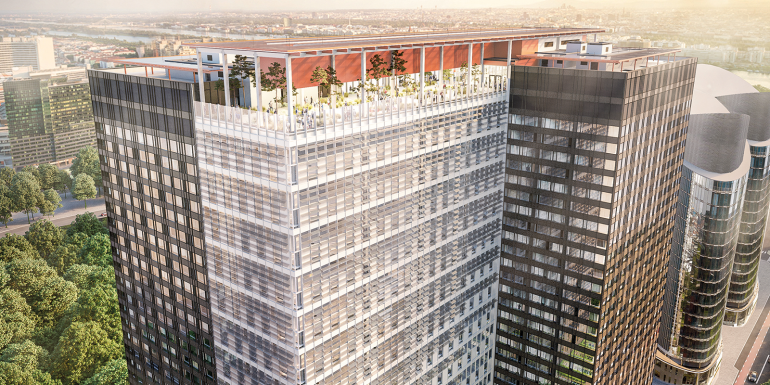
The newly developed World Trade Centre in Brussels, Belgium
CO2 not the most important threat to health of the planet
Chaline Church is an architect and environmental consultant specialising in circular economy materials, and is a founding partner of 540 World, a consultancy specialising in circular design infrastructure that advocates the Cradle to Cradle (C2C) gold standard of materials sustainability. She says: “So what are some best practices to help realise this vision of a circular economy that includes operational energy use, embodied energy use and social impact?
“It’s no longer OK to specify just looking at costs or just looking at carbon. We need to specify in a much more robust, holistic way for the planet. That means empowering the people making those decisions – the specifiers. They need to be able to embed multi-category thinking into their strategies so that social and environmental factors are considered alongside costs and performance.”
Church believes CO2 is not the most important threat to the planet – rather it is aquatic pollution and ocean acidification, largely from microplastics and chemicals used in cosmetics, sunscreen, plastics and paint (bit.ly/3iebfH9). The damage could be devastating to the planet even if we were to achieve net zero in carbon emissions, which is why she underlines how important it is to avoid greenwashing and to get specifiers using materials they can be sure are genuinely sustainable, thanks to hard data and certification.
We must push for higher standards
Another important element is stakeholder engagement – investors, clients, banks, architects and designers, all the people through the chain of conception, construction and living. Contracts should be “fully embedded with key performance indicators (KPIs) so that specified products do not drop off later due to costs”.
There are some great examples of best practice, she notes: the Park 20|20 SHARE Hoofddorp office development in Amsterdam (sharebuilding.nl) is based on the C2C philosophy. Its materials are designed to be reused at the end of their lifespan and its buildings are connected to a grey water purification system. With the UK’s Environment Agency’s flood-risk management programme Thames100, Church’s organisation helped specify Accoya, a fast-growing wood, which (like mycelium) sequesters carbon from the atmosphere as it grows. The wood is acetylated to prevent it from absorbing water, like slower growing but less sustainable hardwoods. In Brussels, a newly developed World Trade Centre is keeping almost three-quarters of the materials from its old buildings and using 95% C2C materials in its offices. And in London, a C2C retrofit at the Ergotec Health Clinic uses Accoya wood and carbon-absorbent Graphenstone paint.
Rigorous standards like C2C are important in meeting the higher threshold of regenerative design among competing definitions of sustainability, greenwashing and a low base level of sustainability regulation. It can be confusing for specifiers, even if they are looking to do the right thing. “We need specifiers to push for the highest design standards,” says Church. Bringing it all together means “engaging management and having contracts, tenders, KPIs, clients and stakeholders empowered and using the language, principles and practice of regenerative design. We need to arm specifiers with data against the arguments of higher costs, lower performance, newer supply chains or service risk.”
To this end, 540 World has launched the UK’s first printed design director for C2C non-toxic, reusable and often carbon-absorbent products, which meet a high sustainability standard.
Church concludes: “Designing as nature, with no pollution or concept of waste, relying on natural energy and celebrating biodiversity from flora to fauna, people to minerals, must be supported by evidence-based data from industry to drive change at pace.”
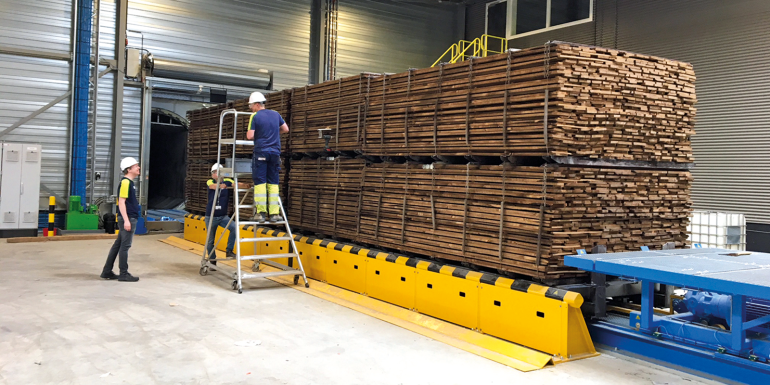
Accoya, a fast-growing wood that sequesters carbon from the atmosphere as it grows
Current construction methods produce far too much waste
Duncan Baker-Brown, an architect and activist, is author of The Re-Use Atlas published by RIBA. “The construction sector consumes half of all raw materials mined and harvested every year. That’s 100bn tonnes of material (compared to between 45bn and 60bn tonnes just a decade ago). In the UK, we consume 600m tonnes of product every year, and throw away a third of it. Most of that waste is from the construction sector – 120m tonnes of waste. We’re responsible for 45% of carbon emissions one way or another. We are a hugely impactful factor.” However, there is potential for impactful change too – reducing a 10x10m concrete screed slab’s thickness by 5cm can save more carbon than giving up meat for a year.
Reuse rather than recycle
With the vast majority of the built environment likely to still be with us by 2050, Baker-Brown points out that we must get the best designers and suppliers involved in retrofit and using fewer resources. There is an important distinction between recycling and reusing: “Recycling is where you crush, shred or melt some source material and make it into something else. It has embodied carbon, waste and problems associated with it. If you can reuse something, that’s far better.” As an example, the Waste House in Brighton is made almost entirely from discarded products without an end-of-life strategy. It’s an example of ‘urban mining’, which is using cities to extract the material to retrofit them, instead of extracting more resources from conventional mines.
Companies like Rotor DC, a co-operative in Brussels, are paving the way with their mission to salvage building materials by deconstructing buildings that would otherwise be demolished, and redistributing materials to new building sites. Having a supplier that can turn those waste materials into products that architects need is important.
For some buildings, such as in financial districts where there is a lot of replacement activity happening, materials can be taken down, restored and put back up – if the supplier still exists. “Suppliers can help us turn linear systems into circular ones,” says Baker-Brown.
Means to an end
The industry needs to innovate and adapt to achieve net zero; that means new ideas, technologies and materials alongside improving the supply chain and bringing suppliers and designers together to improve sustainability.
While these seem ambitious visions, changing the culture of specifiers and buyers remains a tall order. Perhaps there is stability in having, say, suppliers involved in leasing buildings that are reusing their materials, compared to the volatility of existing unsustainable supply chains. Amid anxiety about capital cost, long-term business models can add value and open the way to more sustainable practices. It falls to the industry to articulate the commercial benefits, particularly where building users are invested and willing to pay more for long-term value.
Jones suggests: “Insurers and investment funds may start imposing more liability once they are aware of the huge amount of data in cities that covers environmental issues such as stormwater flooding, recyclability and end-of-life use of product.”
What is clear is that the construction sector, as a large contributor to carbon emissions, has a role to play in creating and maintaining a better environment for the future. In the UK’s Climate Change Committee report in 2022, Lord Deben noted that the government “has willed the ends but not the means” to get us to net zero. Four experts have told Futurebuild that built environment professionals have the means.


